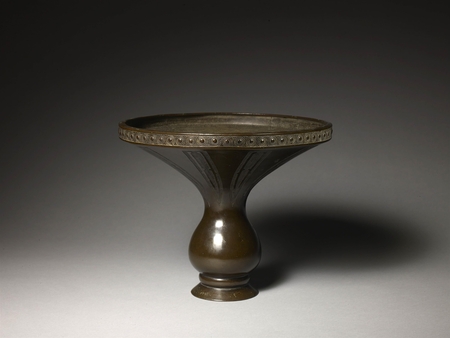Product Description
7231 A bronze flower vessel, the bulbous body with a wide flaring mouth decorated in geometric patterns
Japan 19th century Edo period
Dimensions: H. 22.5cm x Diam. 27cm (9” x 10¾”)
Inspired by Chinese prototypes from the Song and Yuan dynasties, bronze flower vessels have been prized in Japan since the middle ages.
Initially used in Zen temples these objects soon found favour with the ruling classes of Japan leading to the creation of a special place to show these newly fashionable pieces. This new form of interior design was known as the shoin-zukuri, a raised area which formed part a large alcove and a two-tiered shelf for display within a formal room. This format was later developed into the tokonoma, a feature which can be found in nearly every Japanese home to this day.
The emergence of the flower arrangement (ikebana) as a new form of art in the Muromachi period (1336-1573) is evident from various records. Some written sources from the period refer to the flower vessels employed rather than to the flowers used, giving us a clue as the importance of these objects. Bronze in particular was the most popular material for flower vessels and Karamono (Chinese things) were especially favoured by the aristocracy. Many Japanese vessels were made based on ancient Chinese bronze forms and some Japanese bronzes were exported to and much admired in China for their fine casting.
The mouth of this particular vase is regarded as a developed version of the classical form of usubata (thin rim) which is a broad flat top often edged with an upturning lip, a uniquely Japanese design. The innovative, splayed mouth can be filled with water giving a reflective surface for the display, and was one of typical forms of 19th century vases by the metal artist Murata Seimin (1761-1837) and his school.
For an example with a similar neck and mouth shape in the Perry Foundation collection, see Joe Earle, Flower Bronzes of Japan, (London, 1995), p. 96, 100, 101, no. 53.





